Footprints have many stories to tell. Humans once shared a world with giant creatures, and footprints can be a window into those interactions. From the ancient tracks found in White Sands National Park recently to those found in Africa decades ago, tracks provide reliable evidence of occupation. Obtaining accurate age dates is critical–and these dates can bring surprises that force us to shift our understanding of history.
White Sands Tracks
A new story has recently unfolded in White Sands National Park in southern New Mexico. White Sands contains tens of thousands of fossilized trackways, left behind by now-extinct mammoths, camels, dire wolves, saber-toothed cats–and humans. The region is undoubtedly one of the most significant track sites on Earth.
Today the region is an arid, even desolate place, but during the Late Pleistocene it contained Lake Otero, a large body of water surrounded by a rich variety of plant and animal life. Many of the tracks that can be found today were made when the lake was drying up into a flat playa, and small seasonal pools covered the area. Animals and people slipped and slid across muddy surfaces along the edges of these bodies of water, leaving their footprints behind.
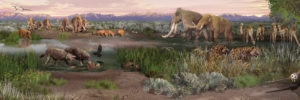
Reconstruction of paleontological landscape at White Sands with a herd of Columbian mammoths, a ground sloth (left background), dire wolves (left foreground), lions (center/left background), camels (right background), and saber-toothed cats (right foreground, in reeds) gathering at a water source
One fascinating set of tracks found was made by a woman or adolescent male, accompanied by a toddler. The trackway goes out and back, extending for almost a mile. At times, the older person carried the toddler with a shift from one hip to another–a change reflected in a broadening of the footprints, which alternated in the direction the foot rotated outward with the added weight. Between the out and back trips, a mammoth and a giant ground sloth crossed the human pathway.
Researchers can tell that the older person was hurrying at a pace of nearly 3.8 miles/hour (6 km/hour) over slick mud. A normal pace, obtained from measurements of the stride lengths from hundreds of other human footprints within the track site, is about 2.7 miles/hour (4.3 km/hour). Why the travelers were in a hurry, we will never know–but avoiding encounters with any local creatures with big teeth prowling about would be a good reason not to stroll. Especially if light was fading as night approached…
Another trackway gives a different story. Over a span of about 10 paces, there are footprints of a giant ground sloth–possibly 10 feet (3 m) tall and weighing 2,000 lbs. (907 kg)–and with human footprints directly inside the tracks of the enormous animal. Then, the tracks suggest that the sloth rose on its high legs, possibly flailing in defense, and a second person tiptoed toward the animal from the side. How this story ended is unknown–but it certainly looks like a hunting encounter. And this unique combination of tracks may be the best direct evidence of Pleistocene interactions between humans and megafauna found anywhere in the world.
Initially, the researchers studying the White Sands’ footprints made the educated guess they were between about 15,000 and 10,00 years old. A surprise was ahead! To obtain an accurate date from radiocarbon techniques, US Geological Survey researchers carefully collected ancient seeds of ditch grass that had grown by the former lake edge and that were associated with the prints. When the analyses were complete, they showed the tracks were much older than suspected—between 23,000 and 21,000 years old! BIG news! These dates imply that people may have arrived in the Americas roughly 7,000 years earlier than the current estimates of approximately 16,000 or so years ago–a major discovery! (More about the First Americans in my post here: https://roseannechambers.com/the-kelp-highway/ )
Links in Africa
And what about the tracks of our ancient ancestors that are really old? Today, our closest living relatives, the chimpanzees, share the family Hominidae with us and a few other primates–all generally referred to as “hominids”, with the narrower term “hominins” used for Homo sapiens and our close extinct relatives. Scientists estimate that the human and chimpanzee lineages probably parted ways around 6 or 7 million years ago; the features of modern Homo sapiens show up in the fossil record around 300,000 years ago.
In 1976, Mary Leakey and her team found a set of ancient hominin footprints at the Laetoli site in Tanzania. These footprints were made in wet volcanic ash and date to 3.6 million years ago. The finding caused great excitement worldwide, as it showed the early age of bipedalism. Although the identity of the individuals who made the Laetoli prints is uncertain, most researchers believe it was Australopithecus afarensis. A. afarensis clearly walked upright, with footprints showing a pronounced heel strike, a well-developed arch, and a deep impression for the big toe. When researchers discovered the Laetoli footprints, they were the oldest bipedal hominins known; since then, even older fossils that suggest bipedalism have been found.
The Laetoli site is about 28 miles (45 km) south of Olduvai gorge, where Mary and Louis Leakey found hominin fossils and stone tools beginning in 1959. The discoveries that they and others have made more recently are dated between about 1.85 to 1.7 million years ago, with other fossils as young as about 600,000 years old.
In Ethiopia in 1974, the 3.2-million-year-old fossilized bones of the famous A. afarensis individual, Lucy, were found at the Hadar site. The nearly 40% complete fossil skeleton of Lucy confirmed upright walking, along with a brain size estimated to be like those of modern gorillas and chimpanzees. The fossils supported the view that bipedalism evolved before an increase in brain size.
In 2015 at Laetoli, more hominin footprints were found nearby and of the same age as the tracks found in 1976. These footprint impressions, from Site S and shown below, are like those of human strides, with the heel striking first, then weight transferred to the ball of the foot, and then a push off from the toes.
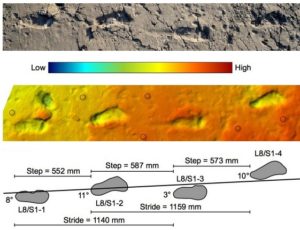
Footprints from Laetoli Site S, dated to approximately 3.6 million years ago
Thousands of other animal tracks, along with fossil bones and teeth, indicate hyenas, baboons, giraffes, rhinos, buffalos and others lived alongside the hominins. These include a five-track set of footprints that was originally attributed to a bear. A reanalysis published recently, however, indicates a hominin made them. Possibly, this was a different species of Australopithecus.
In 2007, what might be the second oldest known set of footprints was found near the shore of Lake Turkana in the Kenyan rift valley. Located near the village of Ileret, researchers believe some prints were made by Homo erectus. These prints date back to about 1.5 million years ago, and groups of footprints reveal the hominins traveled in social groups.
The illustration below shows the distinctive footprint pressure points from Australopithecus afarensis, Homo erectus, and Homo sapiens.
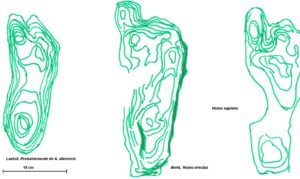
Interpretation of hominin footprint in Laetoli (3.7 My) thought to be from Australopithecus afarensis; Ileret (1.5 My) from Homo erectus, and Homo sapiens. The green lines represent the points under the same pressure/weight.
Footprints and tracks, from trilobites to dinosaurs to mammoths and hominins, provide a glimpse back in time at our changing world. The stories that we can glean from those ancient times are fascinating.
Please share this post! Also, please scroll down to the bottom of this page and leave your email address on my website. You’ll receive messages only when I publish a new post (about once a week) and my occasional newsletter. Join now to learn more about geology, geography, culture, and history.
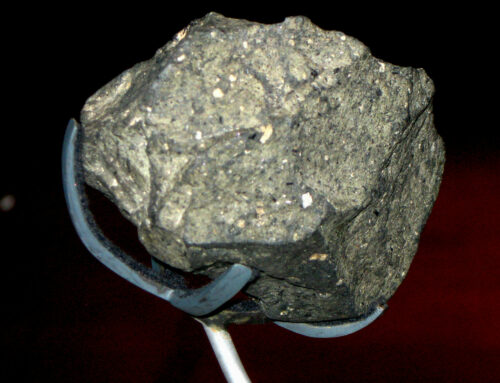
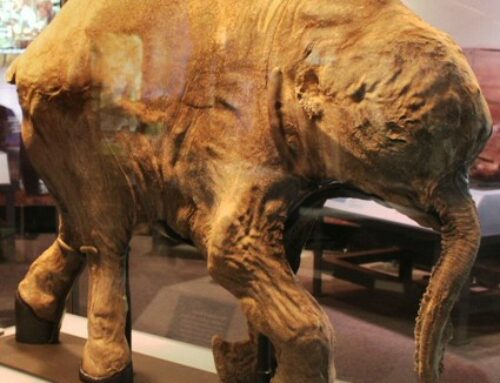

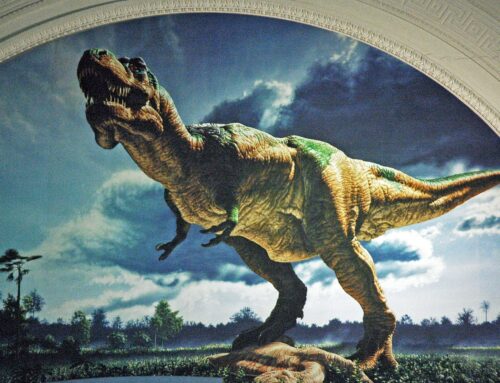

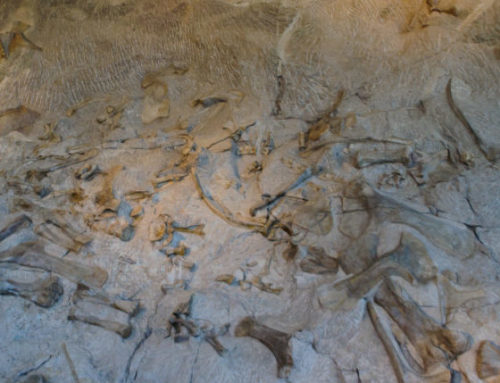
Thank you Roseanne!
Very interesting! Especially the encounter and interactions with the animals of that time!
Thanks!
Fascinating – nice to hear the details concerning the White Sands tracks! Thanks, Roseanne.
Thanks for the comment!